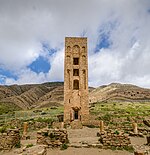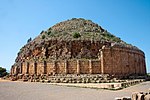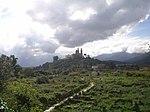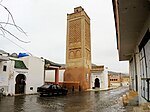List of World Heritage Sites in Algeria
The United Nations Educational, Scientific and Cultural Organization (UNESCO) World Heritage Sites are places of importance to cultural or natural heritage as described in the UNESCO World Heritage Convention, established in 1972.[1] Cultural heritage consists of monuments (such as architectural works, monumental sculptures, or inscriptions), groups of buildings, and sites (including archaeological sites). Natural features (consisting of physical and biological formations), geological and physiographical formations (including habitats of threatened species of animals and plants), and natural sites which are important from the point of view of science, conservation, or natural beauty, are defined as natural heritage.[2] Algeria accepted the convention on 24 June 1974.[3] There are seven World Heritage Sites in Algeria, with a further six on the tentative list.[3]
The first site in Algeria added to the list was Al Qal'a of Beni Hammad, in 1980. The most recent site added was Kasbah of Algiers, which was listed in 1992. Of the seven sites on the list, six are listed for cultural significance while Tassili n'Ajjer is listed for both cultural and natural significance.[3] From 2002 to 2006, Tipasa was listed as endangered because of inadequate management of the site, including vandalism, growing urbanisation in the buffer zone, and unsuitable restoration techniques.[4] Algeria has served on the World Heritage Committee three times.[3]
World Heritage Sites
UNESCO lists sites under ten criteria; each entry must meet at least one of the criteria. Criteria i through vi are cultural, and vii through x are natural.[5]
| Site | Image | Location (province) | Year listed | UNESCO data | Description |
|---|---|---|---|---|---|
| Al Qal'a of Beni Hammad | 
|
M'Sila | 1980 | 102; iii (cultural) | Qal'at Bani Hammad was founded by the Hammadid dynasty in 1007 in a mountain setting, initially as a military stronghold that became their capital. It was influential in the development of the Arab architecture, including in the Maghreb, Andalusia, and Sicily. It was abandoned in 1090 under the threat of the Banu Hilal invasion and later demolished in 1152. The main mosque (the remains of the minaret pictured) was one of the largest and oldest in Algeria.[6] |
| Tassili n'Ajjer | 
|
Tamanrasset | 1982 | 179; i, iii, vii, viii (mixed) | The vast sandstone plateau has numerous rock formations, created by water and wind erosion. There are Precambrian rocks and sediment sequences that are of high geological interest. There are more than 15,000 rock paintings and carvings in the area, making it one of the richest prehistoric rock art sites in the world. The images cover the period from around 10,000 BCE to the first centuries of CE. They depict human figures and animals and illustrate the evolution of society and changes of the climate. Some of the depicted animals, such as the hippopotamus, were present in periods with more water, but have now been absent for millennia.[7] |
| M'Zab Valley | 
|
Ghardaïa | 1982 | 188; ii, iii, iv (cultural) | The five ksour (singular ksar) in the M'Zab Valley were founded between 1012 and 1350 by the Ibadites. Ksar is a type of a fortified village adapted to a harsh desert environment. Each of the five ksour has a mosque that can act as a fortress with a minaret that is also a watchtower, as well as an adjacent cemetery and palm grove. Up to the present day, people have maintained essentially the same building techniques as in the 11th century. In the 20th century, the ksour model influenced architects and urban planners, including Le Corbusier. Mzab Ghardaïa is pictured.[8] |
| Djémila | 
|
Sétif | 1982 | 191; iii, iv (cultural) | The Roman town of Djémila was founded in the late 1st century under the Emperor Nerva. It was a defensive settlement, located at an elevation of 900 m (3,000 ft). It expanded in the 3rd century and declined with the collapse of Rome in the 6th century. Today in ruins, there are remains of the forum, temples, basilicas, triumphal arches, and houses, as well as early Christian sites, including a large cathedral and baptistery. A collection of mosaics has been preserved, depicting mythological and everyday motifs.[9] |
| Tipasa | 
|
Tipaza | 1982 | 193; iii, iv (cultural) | Tipasa was founded in the 6th century BCE as a Punic trading post and port of call. A vast necropolis remains from this period and testifies to the cultural exchanges of peoples in the region. It was conquered by the Romans in the 2nd century BCE. Buildings dating from the Roman period include the Royal Mausoleum of Mauretania (pictured). There are Christian buildings from the 3rd and 4th centuries. In the 430s, the city was taken by the Vandals, retaken by the Byzantines, and declined in the 6th century. From 2002 to 2006, the site was listed as endangered because of inadequate management of the site, including vandalism, growing urbanisation in the buffer zone, and unsuitable restoration techniques.[4][10] |
| Timgad | 
|
Batna | 1982 | 194; ii, iii, iv (cultural) | Timgrad was founded as a Roman military colony by the Emperor Trajan in 100. It had a triumphal arch, temples, markets, and baths. It is a good illustration of Roman urban planning. The city fell into decline with the Vandal invasion in 430 and was finally abandoned in the 8th century, following the Arab invasion.[11] |
| Kasbah of Algiers | 
|
Algiers | 1992 | 565; ii, iv (cultural) | The Phoenician trading post from the 6th century BCE, it got its present layout in the 16th century under the Ottomans. It has old mosques, Ottoman-style palaces, souks, hammams, and traditional buildings that reflect the life in a Mediterranean Muslim city. At the time of inscription, it was home to around 50,000 people. An interior of a palace is pictured.[12]
|
Tentative list
In addition to sites inscribed on the World Heritage List, member states can maintain a list of tentative sites that they may consider for nomination. Nominations for the World Heritage List are only accepted if the site was previously listed on the tentative list.[13] Algeria maintains six properties on its tentative list.[3]
| Site | Image | Location (province) | Year listed | UNESCO criteria | Description |
|---|---|---|---|---|---|
| Oases with foggaras and ksour of the Grand Erg Occidental | 
|
Adrar, Béchar | 2002 | ii, iii, iv, v (cultural) | The Oued Saoura cut a valley in the Grand Erg Occidental. This was a major caravan route to Gao in Mali. There are numerous ksour, or fortified tribal villages, in the valley, some of which are still occupied. Since the 1st millennium AD, the villagers were maintaining foggaras, underground aqueducts that connect the underground aquifers with the palm groves in depressions. Some of the ksour include Timimoun (pictured), Timoudi, and Kerzaz.[14] |
| The Augustinian sites of the central Maghreb | 
|
several sites | 2002 | ii, iii, iv, vi (cultural) | This nomination comprises a series of archaeological sites connected to the early Christian theologian and philosopher and one of the most important Church Fathers of the Latin Church, Saint Augustine of Hippo. He was born in 354 in Thagaste and died in 430 in Hippo Regius, today's Annaba (Roman ruins of the city with a 19th century Saint Augustin Basilica pictured).[15]
|
| Nedroma and the Trara | 
|
Tlemcen | 2002 | ii, iii, iv, v (cultural) | Nedroma, in the Trara Mountains, was founded in the 12th century. After the Reconquista, it became home to many people of Moorish origin who left Andalusia. In the 16th century, is was an important textile centre. The Great Mosque is pictured.[16] |
| Oued Souf | 
|
El Oued | 2002 | ii, iii, iv, v (cultural) | El Oued is an oasis town that is built above an underground aquifer which allows growing of palms that are planted in vast tunnels in the sand, directly above the water table. This type of agriculture requires constant maintenance and removing of the accumulating sand.[17] |
| The Royal Mausoleums of Numidia and Mauretania and pre-Islamic funerary monuments | 
|
several sites | 2002 | ii, iii, iv (cultural) | This nomination comprises four mausolea from 3rd to 1st centuries BCE that were built for rulers of Numidia and Mauretania (the Royal Mausoleum of Mauretania, which is already listed as a World Heritage Site with Tipasa, tomb of Masinissa in El Khroub, pictured, Madghacen, and the Mausoleum of Beni-Rhénane), and the tombs from the 5th and 6th centuries, Jedars and the Tin Hinan Tomb.[18] |
| Aurès with the oasis settlements of the Rhoufi and El Kantara gorges | 
|
several sites | 2002 | ii, iii, iv, v, vii, x (mixed) | The Aurès Mountains reach above 2,000 m (6,600 ft) and provide different types of habitats, including the Quercus ilex, cedar, and Aleppo pine forests at higher elevations and palm groves in valleys. Traditionally, the region has been inhabited by Berbers who constructed settlements adapted to mountain environment, such as El Kantara and Menaâ. Houses in Ghoufi (Rhoufi) are pictured.[19] |
References
- ^ "The World Heritage Convention". UNESCO World Heritage Centre. Archived from the original on 27 August 2016. Retrieved 7 July 2019.
- ^ "Convention Concerning the Protection of the World Cultural and Natural Heritage". UNESCO World Heritage Centre. Archived from the original on 1 February 2021. Retrieved 3 February 2021.
- ^ a b c d e "Algeria". UNESCO World Heritage Centre. Archived from the original on 15 August 2023. Retrieved 19 August 2023.
- ^ a b "Decision 30 COM 8C.3 Updates of the World Heritage List in Danger (Removed Properties)" (PDF). UNESCO World Heritage Centre. Archived (PDF) from the original on 5 April 2023. Retrieved 19 August 2023.
- ^ "The Criteria for Selection". UNESCO World Heritage Centre. Archived from the original on 12 June 2016. Retrieved 17 August 2018.
- ^ "Al Qal'a of Beni Hammad". UNESCO World Heritage Centre. Archived from the original on 15 August 2023. Retrieved 18 February 2024.
- ^ "Tassili n'Ajjer". UNESCO World Heritage Centre. Archived from the original on 4 April 2022. Retrieved 18 February 2024.
- ^ "M'Zab Valley". UNESCO World Heritage Centre. Archived from the original on 22 September 2022. Retrieved 18 February 2024.
- ^ "Djémila". UNESCO World Heritage Centre. Archived from the original on 3 February 2024. Retrieved 18 February 2024.
- ^ "Tipasa". UNESCO World Heritage Centre. Archived from the original on 27 January 2024. Retrieved 18 February 2024.
- ^ "Timgad". UNESCO World Heritage Centre. Archived from the original on 27 January 2024. Retrieved 18 February 2024.
- ^ "Kasbah of Algiers". UNESCO World Heritage Centre. Archived from the original on 27 January 2024. Retrieved 18 February 2024.
- ^ "Tentative Lists". UNESCO World Heritage Centre. Archived from the original on 24 September 2005. Retrieved 7 October 2010.
- ^ "Les oasis à foggaras et les ksour du Grand Erg Occidental" (in French). UNESCO World Heritage Centre. Archived from the original on 25 April 2022. Retrieved 18 February 2024.
- ^ "The Augustinian sites of the central Maghreb" (in French). UNESCO World Heritage Centre. Archived from the original on 10 October 2021. Retrieved 18 February 2024.
- ^ "Nedroma and the Trara" (in French). UNESCO World Heritage Centre. Archived from the original on 25 April 2022. Retrieved 18 February 2024.
- ^ "Oued Souf" (in French). UNESCO World Heritage Centre. Archived from the original on 25 April 2022. Retrieved 18 February 2024.
- ^ "The Royal Mausoleums of Numidia" (in French). UNESCO World Heritage Centre. Archived from the original on 25 April 2022. Retrieved 18 February 2024.
- ^ "Parc des Aurès avec les établissements oasiens des gorges du Rhoufi et d'El Kantara" (in French). UNESCO World Heritage Centre. Archived from the original on 25 April 2022. Retrieved 18 February 2024.


